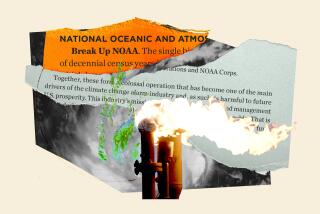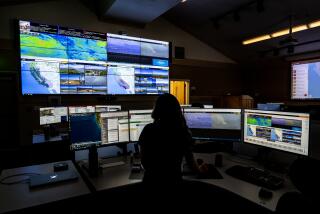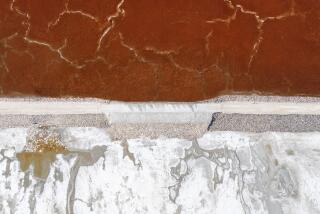They Can’t Give You Next Week’s Forecast, but They Know What Happened in 1890 : Climatic Center Stores a Century of Weather Under Leaky Roof
ASHEVILLE, N.C. — Perhaps it’s fitting that the world’s largest repository of weather records is housed in a 1920s-vintage indoor shopping mall that leaks during downpours.
Accurate weather records dating back to 1890--some even to the time of the Pilgrims at Plymouth Rock--are available at the National Climatic Data Center, which has dozens of cubbyhole offices in the the historic building guarded by two terra-cotta griffins.
“Every time it rains hard the roof leaks and we have to break out the buckets,” says Steve Doty, the center’s project director.
Despite the accommodations, the center, with a staff of 300, turns out an impressive amount of weather information, answering 85,000 queries last year alone.
‘Historical Perspective’
“We can’t give you the weather forecast for next week but we can give you a look back 100 years,” Doty says. “Our role is to supply the historical perspective.”
The center’s long view at the world’s climate can be vital when it comes to such things as fighting world hunger, sending astronauts into space or winning court cases.
For example, when an Exxon tanker spilled 10 million barrels of oil in March into Prince William Sound in Alaska, industry and government experts called the center to learn what kind of weather conditions could be expected during the cleanup.
By coincidence, the center had just published a climatic atlas of the area, which provided detailed information on temperatures, wind speed and ocean currents.
Bill Brower, who helped prepare the atlas, says the data showed that the 70-m.p.h. winds that hit the Valdez area at the time of the accident were unusual for that time of year. The information was beneficial as cleanup efforts were coordinated.
‘Normals and Extremes’
“What we offer is a lot of good, hard science,” Doty says. “We can tell you normals and extremes so you know what to expect.”
Although keeping weather records may seem like dull work, some of the greatest minds in U.S. history have shown an interest in it.
Ben Franklin, Thomas Jefferson and George Washington Carver all were amateur weather observers. Copies of their records can be found at the center, which is part of the U.S. Commerce Department’s National Oceanic and Atmospheric Administration.
The tons of records stored in the center’s basement are testimony to generations of less-famous volunteer weather trackers.
“We’ve even got a copy of a diary with weather records from Plymouth Rock,” Doty says.
Most of the bound records stored in what once was the mall’s underground parking deck come from places such as Vicksburg, Miss., St. Joseph, Mo., or Bear Mountain, N.Y., since 1890.
Raw Data
So if you’ve just got to know how many times it snowed in Chicago on April 30 for the last 99 years, the folks at the NCDC can help.
The raw data comes from the military, the National Weather Service, the Federal Aviation Administration and 8,000 volunteer weather observers. Hourly weather observations pour in from around the globe, much of them from 10,000 ships stationed in various positions and from weather satellites orbiting Earth.
Current records are stored on computer. But because of budget constraints the center has been able to save on microfiche only a fourth of the 200 million paper records.
In 1951, the center was moved from New Orleans to Asheville in the mountains of western North Carolina. The city had a pool of workers skilled in key-punch machines, so the government bought the Arcade Building and set up shop.
Stuffed With Computers
At one time, the sprawling building that takes up an entire city block was bulging at the seams with key-punch cards. Now its rooms are stuffed with computers and microfiche readers.
The center prints about 5,000 different publications on such topics as hourly precipitation data by state, national storm data and global climatic data. The publications go out to more than 50,000 individuals and businesses.
Seven staff meteorologists answer thousands of telephone and mail queries each month. Over the years, they have been asked some peculiar questions, including:
* A free-lance writer wanted to know what the weather was like during the Oct. 30, 1938, radio broadcast of the “The War of the Worlds.”
* Actress Carol Burnett called to find out whether thunderstorms and hail hit the San Antonio area on April 26, 1933, the day she was born.
* A company planning to shoot a television commercial wanted to know where in the United States they were likely to find snow on the ground in November. They were instructed to shoot on location in Stampede Pass, Wash., which averages 64 inches of snow each November.
* A Texas law firm requested wind speed and direction records for a client who was planning to build a chicken coop. The lawyers wanted to show that the odors from the coop would not be blown to surrounding homes.
* A chocolate candy company planning a summer publicity campaign requested nighttime temperatures in several Midwestern towns to help them pinpoint the best time to leave samples on doorsteps.
One out of three requests come from attorneys trying to reconstruct weather conditions in accident or criminal cases, says Sam McCown, the center’s supervisory meteorologist.
Wide Range of Cost
The minimum charge for information was increased recently to $12, while the average cost is about $40. Some complicated requests can cost several thousand dollars.
Last summer, the center set up a special office to handle requests for drought-related information. Calls came in from all over the country.
Richard Heim, who was in charge of the drought office, said records on file from the 1930s and the 1950s put last year’s dry weather into perspective.
At the peak of the 1988 drought, about 26% of the country was classified as experiencing extreme drought. On his computer, Heim called up a map from 1934 that showed 45% of the country suffering from extreme drought.
The weather records also help scientists explore such things as the “greenhouse effect,” a warming of Earth’s temperatures that has been attributed to industrial growth.
More to Read
Sign up for Essential California
The most important California stories and recommendations in your inbox every morning.
You may occasionally receive promotional content from the Los Angeles Times.










